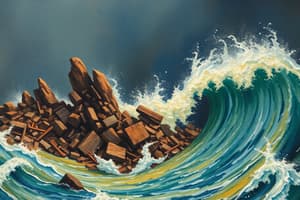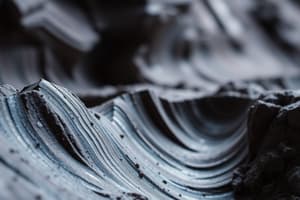Podcast
Questions and Answers
What causes earthquakes to occur?
What causes earthquakes to occur?
- The expansion and contraction of the Earth's lithosphere (correct)
- The movement of the Earth's atmosphere
- The melting of the Earth's polar ice caps
- The rotation of the Earth around the sun
What are the principal tectonic plates that comprise the Earth?
What are the principal tectonic plates that comprise the Earth?
- Mantle and crust plates
- Atmospheric and lithospheric plates
- Oceanic and continental plates (correct)
- Inner core and outer core plates
What are some effects of significant earthquakes?
What are some effects of significant earthquakes?
- Volcanic eruptions, hailstorms, and tornadoes
- Buildings crumbling, roads and bridges cracking, and landslides occurring (correct)
- Forest fires, hurricanes, and droughts
- Air pollution, acid rain, and ozone depletion
What are seismic waves?
What are seismic waves?
What are the two main types of seismic waves?
What are the two main types of seismic waves?
Which type of seismic waves are slower but can cause significant damage to structures?
Which type of seismic waves are slower but can cause significant damage to structures?
What causes the ground to swing like a pendulum?
What causes the ground to swing like a pendulum?
What type of boundaries result in stress accumulation and can be released in the form of earthquakes?
What type of boundaries result in stress accumulation and can be released in the form of earthquakes?
What is the primary cause of earthquakes at convergent boundaries?
What is the primary cause of earthquakes at convergent boundaries?
What do seismometers measure to give scientists valuable insight into earthquake activity?
What do seismometers measure to give scientists valuable insight into earthquake activity?
Flashcards
Earthquake Cause
Earthquake Cause
Earthquakes are caused by the movement and interaction of tectonic plates, which release stored energy leading to vibrations.
Tectonic Plates
Tectonic Plates
Large sections of the Earth's lithosphere that move slowly, causing earthquakes and shaping the Earth's surface.
Seismic Waves
Seismic Waves
Vibrations that travel through the Earth's interior and surface after an earthquake.
Body Waves
Body Waves
Signup and view all the flashcards
Surface Waves
Surface Waves
Signup and view all the flashcards
Convergent Boundaries
Convergent Boundaries
Signup and view all the flashcards
Divergent Boundaries
Divergent Boundaries
Signup and view all the flashcards
Transform Boundaries
Transform Boundaries
Signup and view all the flashcards
Earthquake Effects
Earthquake Effects
Signup and view all the flashcards
Earthquake Risk Assessment
Earthquake Risk Assessment
Signup and view all the flashcards
Study Notes
Earthquakes: Unraveling the Foundations of Seismic Events
On a sunny afternoon, as the world goes about its business, the Earth's crust might suddenly lurch and jolt, creating a phenomenon known as earthquakes. These events, far from being static, are powerful reminders of the planet's dynamic nature. In this article, we'll explore earthquakes' causes, effects, seismic waves, tectonic plates, and risk assessment, providing a comprehensive understanding of this fascinating and sometimes frightening natural phenomenon.
Causes: The Earth's Restless Core
Earthquakes occur due to the planet's internal heat, which causes the Earth's lithosphere (the solid outer shell) to contract and expand in a continuous dance of movement. This movement is facilitated by the two principal tectonic plates that comprise the Earth—the oceanic and continental plates. The oceanic plates are denser and colder, while the continental plates are lighter and hotter. The movement and interaction between these plates generate stress and energy that can be released as earthquakes.
Effects: Rattling, Shaking, and Shifting
Earthquakes can have profound and far-reaching effects on the Earth's surface and inhabitants. A significant earthquake can cause buildings to crumble, roads and bridges to crack open like a puzzle, and landslides and tsunamis to occur. Earthquakes also create seismic waves, which propagate through the Earth and can be heard, felt, and, in some cases, even seen.
The shaking and ground movement caused by earthquakes can result in casualties, extensive structural damage, and even long-lasting economic impacts. For instance, the 1995 Kobe earthquake in Japan caused nearly 6,500 deaths, 45,000 injuries, and $100 billion in damages.
Seismic Waves: The Pulse of the Earth
Seismic waves are the vibrations that propagate through the Earth's interior and surface due to the movement of Earth's tectonic plates. These waves can travel in three different modes:
-
Body Waves (Primary and Secondary Waves): Primary waves (P-waves) are the first waves to arrive at a seismometer and are compressional in nature. Secondary waves (S-waves) follow P-waves and are shear waves that cause the ground to swing like a pendulum.
-
Surface Waves: These waves, also known as Rayleigh and Love waves, are slower than body waves but can cause significant damage to structures and infrastructure due to their longer duration and more complex patterns.
Seismometers are sensitive instruments that measure the amplitude and frequency of seismic waves, giving scientists valuable insight into earthquake activity and helping predict potential seismic hazards.
Tectonic Plates: The Earth's Puzzle Pieces
As mentioned earlier, tectonic plates play a crucial role in the generation of earthquakes. These plates move due to convection currents within the Earth's mantle, which results in stress and strain at their boundaries. The boundaries of these plates can be divided into three primary types:
-
Convergent boundaries: When two plates move towards each other, the denser oceanic plate subducts under the lighter continental plate, causing a deep-focus earthquake.
-
Divergent boundaries: When two plates move apart, magma rises from the mantle and forms new crust, creating shallow-focus earthquakes.
-
Transform boundaries: When two plates slide past each other, stress accumulates and can be released in the form of earthquakes.
Understanding the interaction between tectonic plates and their boundaries is essential for predicting earthquake occurrence and developing effective mitigation strategies.
Risk Assessment: Predicting the Unpredictable
Earthquake risk assessment is a complex and ongoing process that involves a combination of scientific data, prediction techniques, and community-based resilience strategies. Seismologists and engineers study the Earth's interior, the movement of tectonic plates, and other relevant factors to predict earthquake occurrence and magnitude.
In addition to scientific prediction, community-based resilience strategies are crucial for reducing the impact of earthquakes on citizens. These strategies include building codes that promote earthquake-resistant structures, early warning systems, emergency response plans, and public education programs.
In conclusion, earthquakes are an awe-inspiring yet sometimes devastating phenomenon that has shaped the Earth's surface and inhabitants for eons. Understanding their causes, effects, seismic waves, tectonic plates, and risk assessment is essential for reducing their impact and promoting a safer and more resilient world.
Studying That Suits You
Use AI to generate personalized quizzes and flashcards to suit your learning preferences.
Description
Test your knowledge about earthquakes' causes, effects, seismic waves, tectonic plates, and risk assessment with this comprehensive quiz. Explore the fundamental concepts related to earthquakes and enhance your understanding of this fascinating natural phenomenon.





